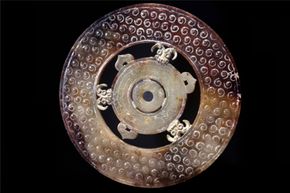Key Takeaways
- There is no evidence to support the existence of the Dropa stones, supposedly discovered in China and linked to an ancient alien civilization.
- The myth includes a detailed narrative involving a Chinese archaeologist and professor who allegedly found and translated the stones, but investigations show no record of these individuals or the stones.
- Despite the intriguing story, the Dropa stones are regarded as a hoax, with their origins traced back to stories published in the 1960s with no credible sources or academic backing.
Let's just get it out of the way: The Dropa stones (sometimes called the Dzopa Stones) are not a real archaeological or historical discovery. To make it even plainer, they aren't a discovery of any kind, because no one has proven they exist, period. So forewarned is forearmed: We're discussing a made-up thing with no academic or scientific proof. That means that while we might see sources claiming otherwise, those sources have an agenda separate from evidence-based reporting. But hey, this doesn't mean we can't learn about the Dropa stones and the story that has grown around them.
It all starts in China, where a Chinese archaeologist found some caves that were apparently being used as a kind of graveyard for the remains of short little beings with large, oval heads. Along with the bodies, 716 stone discs were found, lined with spiral grooves. The discs were sent to various people, including a Chinese professor, who said the grooves were actually written characters. But no worries: He translated the text. It told the story of the Dropa aliens, who crashed their spacecraft in the region 12,000 years ago and tried to make a go of it on Earth until the locals hunted down and killed them. Tragically, the hero professor had to resign in disgrace when no one believed him, and the stones were shuttled about -- maybe to Russia, maybe not -- and disappeared forever [source: Fitzpatrick-Matthews].
Advertisement
Now, keep in mind that the story we've told here is vague and nonspecific; the full myth also provides names and places attached to all these people and the stones they allegedly found. But the big problem? There's absolutely no evidence that the Chinese archaeologist, the professor or the stones ever existed, period. The story was published a couple of times (in piecemeal form) in 1960, before getting the full treatment in a 1962 write-up (in a German magazine for vegetarians -- the place for breaking archaeological news). The author got the story published again in 1964, but this time, at least, it appeared in a UFO magazine. Both stories credited their source to a made-up news agency. It was republished from there, and the legend grew [source: Fitzpatrick-Matthews].
None of the names of the people checked out: The Chinese archaeologist was never on record anywhere, and the Chinese professor -- and his university -- seemed to be made from whole cloth. (Also note that the name given him -- Tsum Um Nui -- isn't even a real Chinese name.) There is indeed an indigenous group in Tibet called the Dropka, but they appear to be completely human.
So, are the Dropa stones authentic?
Nope! Moving on.
Advertisement

